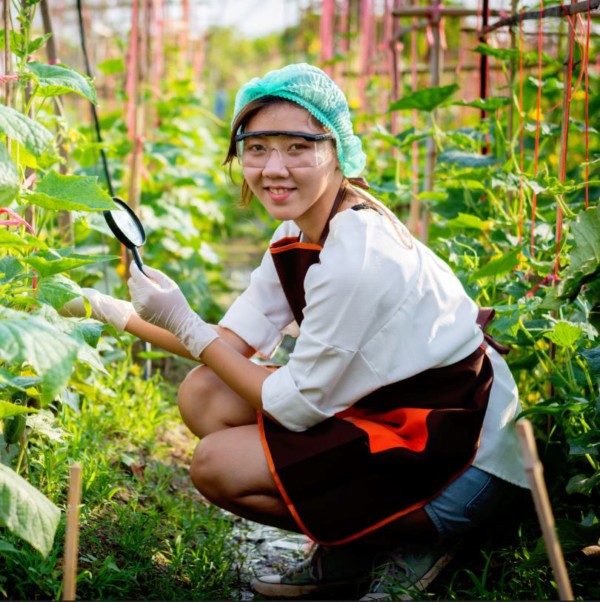Introduction
Math is an essential part of conducting and analyzing scientific research. This week, our word problems delve into the fields of biology, demography, ecology and epidemiology.
Read this week’s description with your child. Choose the word problem that’s the right skill level for them and have them give it a try! After they feel they’ve found the answer, check out the solution!
Math and Science Working Together
Science is anything you can study and observe, and it can be really fun! You can study how fast plants grow and bacteria spreads, the population of animals, and you can even make models of things you observe in nature. Math makes experimenting, collecting data, and learning from the results possible – let’s practice using it to carry out scientific studies!
Pick the word problem below that’s the right skill level for you. Take your time working it out. When you feel you’ve found the answer, see below to check your solution against ours. No peeking, and have fun!
Lower Elementary:
Question: Grace plants a pea for her science fair project and measures how much it grows each week. The first week, it grows 2 inches. After 2 weeks, it is 5 inches tall. After 3 weeks, it is 9 inches tall. After 4 weeks, it is 14 inches tall. After 5 weeks, it is 20 inches tall. If the pattern continues, how tall will the pea plant be after 6 weeks?
Upper Elementary:
Question: Natalie collects water samples from 6 random puddles around her neighborhood and counts the number of mosquito larvae in each. She finds 12, 22, 0, 13, 8, and 13 larvae in the samples. What is the average number of larvae per water sample that Natalie collected?
Middle School:
Question: Bill’s science fair project is to test the different bacteria in the mouths of dogs and people. He swabs his own mouth and his dog’s mouth and then dabs a square centimeter of each in separate petri dishes. If the human mouth bacteria colony grows by a factor of 3 each day and the dog bacteria colony grows by a factor of 11⁄2 each day, then how much bigger will the area covered by the human bacteria be after 3 days?
Algebra and Up:
Question: Luke makes a paper mache, right-circular-cone-shaped volcano model for his science fair project. The cone is 1 foot tall before he cuts off the top, which makes the volcano 2 inches shorter. If the area of the circular base of the cone is 144π square inches, then what is the volume of the volcano model after its top has been removed? (Hint: The volume of a cone is 1⁄3 of the area of its base times its height.)
Solutions
Lower Elementary:
Answer: 27 inches tall
Solution: The plant grew 2 inches the first week, 5 – 2 = 3 inches the second week, 9 – 5 = 4 inches the third week, 14 – 9 = 5 inches the fourth week, and 20 – 14 = 6 inches the fifth week. The pattern is that it grows 1 more inch each week than it did the last. So, it will grow 7 inches the sixth week, making it 20 + 7 = 27 inches tall.
Upper Elementary:
Answer: 111⁄3 mosquito larvae
Solution: To find the average, we add up all the numbers of larvae and then divide by the number of samples. Natalie collected a total of 12 + 22 + 0 + 13 + 8 + 13 = 68 mosquito larvae in her samples. So, the average number of mosquito larvae in a sample is 68 ÷ 6 = 111⁄3.
Middle School:
Answer: 235⁄8 square centimeters
Solution: Over three days, the human bacteria colony triples in area 3 times. So, the human bacteria colony will be 1 × 3 × 3 × 3 = 27 square centimeters. The dog bacteria does the same thing, but its factor is 11⁄2, so it will be 1 × 1 1⁄2× 11⁄2 × 11⁄2 = 1 × 3⁄2 × 3⁄2 × 3⁄2 = 27⁄8 = 3 3⁄8. So, the human bacteria colony is 27 – 33⁄8 = 235⁄8 square centimeters bigger.
Algebra and Up:
Answer: 5731⁄3 π cubic inches
Solution: Here’s one way to find the difference in volume between the cut-off cone and the volume of the whole cone: The whole cone is 1⁄3 × 144π × 12 = 576π cubic inches before the top is removed. The dimensions of the cut-off cone are 2 ÷ 12 = 1⁄6 those of the whole. Since the base is in two dimensions, its area is 1⁄6 × 1⁄6 × 144π = 4π square inches. The volume of the cut-off cone is 1⁄3 × 4π × 2 = 22⁄3 π cubic inches, and the difference is 5731⁄3 π cubic inches.

 877-601-6284
877-601-6284 877-601-6284
877-601-6284
















